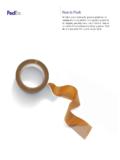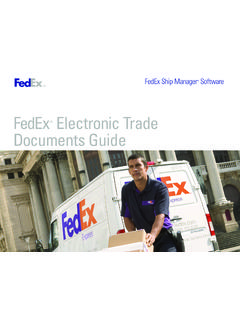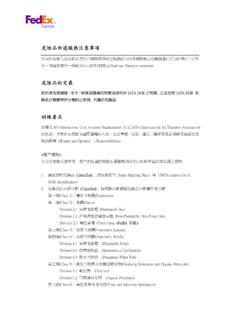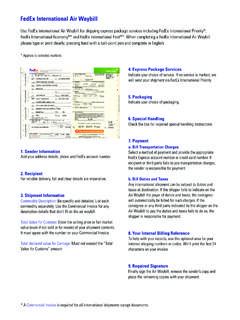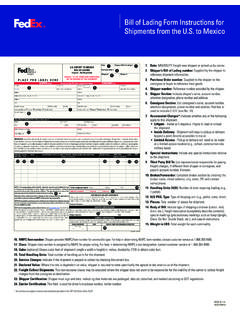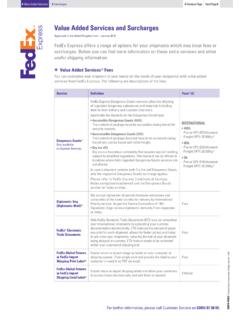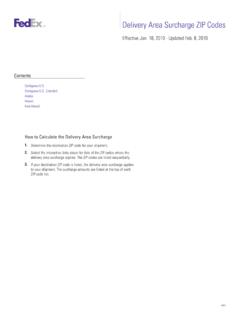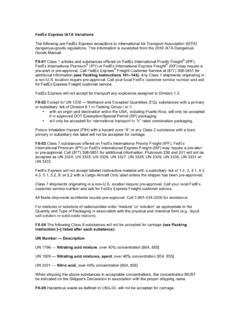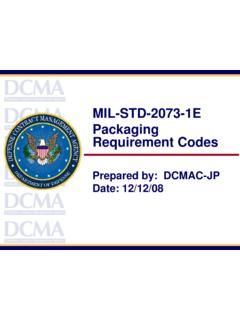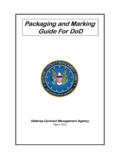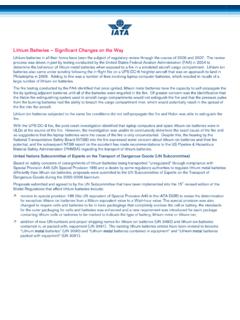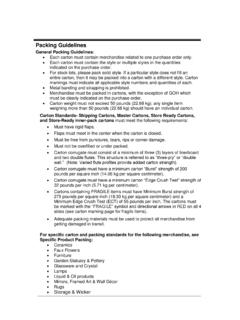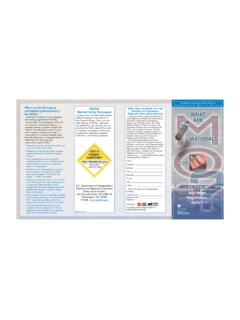Transcription of How to Pack - FedEx
1 how to pack Whether you're looking for general guidelines for packing day-to-day shipments or specific guidelines for shipping specialty items, you'll find it all here in our series of comprehensive packaging guides. Click the one you want. Print just what you need. Contents Click the guide you want. General packaging Guidelines 3. packaging Perishable Shipments 8. packaging Flowers and Plants 15. packaging Computer Shipments 19. packaging Clinical Samples 25. packaging UN 3373 Shipments 29. Automotive and Mechanical Parts Shipments 33. packaging Battery Shipments 41. General packaging Guidelines At FedEx , we know proper packaging can help ensure that your shipments arrive safely. So we offer general packaging guidelines from measuring and weighing your package, to packing methods, sealing and labeling instructions, and guidelines for restricted shipments.
2 Contents Shipment Size and Weight Restrictions 4. General packaging Guidelines 4. General packing Methods 5. Sealing Your Package 6. Addressing and Labeling Your Package 6. packaging Specialty Shipments 7. Back to how to pack contents Shipment Size and Weight Restrictions Calculating Dimensional Weight W. ith FedEx Express International services, you can Dimensional weight applies when your package is ship packages up to 68 kg (150 lbs.); up to 274 cm relatively light compared with its volume. If the (108") in length and 330 cm (130") in length and girth. dimensional weight exceeds the actual weight, charges based on the dimensional weight will be ith FedEx Express Freight Services, you can ship W. assessed. To calculate it: individual skids of 68 kg (150 lbs.) or more. Skids exceeding 997 kg (2,200 lbs.)
3 In weight or exceeding M. ultiply length by width by height in centimeters 178 cm (70") in height, 302 cm (119") in length or or inches. 203 cm (80") in width require prior approval. Divide by 5,000 for centimeters or by 305 for inches. Compare the dimensional weight and actual weight. Yellow and black safety heavyweight labels will be placed by FedEx over the diagonal corners of your package if it weighs more than 32 kg (70 lbs.). General packaging Guidelines U. se FedEx Express packaging for FedEx Express package shipments only; any other use is prohibited. Measuring Length and Girth Y ou may use your own packaging if boxes are sturdy The length and girth formula is simple. Here's what you do: and undamaged with all flaps intact. Measure the length, height, and width of the package.
4 C hipboard boxes, such as gift or shoe boxes, must be L ength and girth equals length plus twice the width packed into a corrugated outer box. and twice the height. Use double-wall boxes for heavier items. P lace small packages inside a larger outer box. For express shipments smaller than 18 cm x 10 cm x 5 cm (7" x 4" x 2"), use a FedEx Express packaging option. Length and Girth Formula D. ouble-box fragile items with 8 cm (3") of cushioning Girth is in and around the smaller box. (2 x width) + (2 x height). W. rap items individually with cushioning material and center them in cartons away from other items and away from the sides, corners, top, and bottom of the box. Height P osition bottles that contain liquids upright. Use an inner seal and perforated breakaway cap. The inner packaging must be able to contain leaks.
5 Width P lace items that might be damaged by normal Length handling, such as soiling, marking, or application of adhesive labels, in a protective outer box. Length is the longest side of the package or object. F or odd- or irregular-shaped items, at a minimum you should wrap and tape all sharp edges or protrusions. E nclose an extra label, business card, or letterhead with the shipper's address and phone number and the recipient's address and phone number inside the package before sealing it. R emove all old address labels from reused boxes before shipping, and make sure there are no holes, tears, or corner dents in the outer box. Back to contents Page 4. General packing Methods Box-in-Box packing Method Follow these general guidelines for the two most W. rap product(s) individually with at least 5-cm (2").
6 Popular packing methods, plus recommendations for thickness of air-cellular cushioning or foam material to odd- or irregular-shaped shipments. fit snugly inside a corrugated box. R estrict product movement inside the box using filler like crumpled newspaper, loosefill peanuts, or other Single-Box packing Method cushioning material. S hip nonfragile products like soft goods inside a C lose and tape the inner box using the H taping sturdy outer box. method. This will help prevent accidental opening. U. se fillers like crumpled newspaper, loosefill peanuts, U. se a second box that is at least 15 cm (6") longer, or air-cellular cushioning material such as Bubble wider, and deeper than the inner box. Wrap to fill void spaces and prevent movement of goods inside the box during shipping.
7 C hoose the wrap or fill method to cushion the inner box inside the larger sturdy outer box. P lace goods that might be affected by dirt, water, or wet conditions inside a plastic bag. S hip fragile products individually, wrapping them in a minimum 8-cm (3") thickness of air-cellular C onsolidate small parts or spillable granular products cushioning material. in a strong sealed container, such as a burlap or siftproof plastic bag, then package in a sturdy W. rap the inner box with 8-cm (3") thickness of air- outer box. cellular cushioning material or use at least 8 cm (3"). of loosefill peanuts or other cushioning material to fill Use the H taping method for sealing your package. the spaces between the inner box and outer box on the top, bottom, and all sides. Single Box With Wrapped Item Fill any void spaces with more cushioning material.
8 Product wrapped in a minimum 8-cm Use the H taping method for sealing your package. (3") thickness of cushioning material Sturdy Box in Box With Loosefill Peanuts outer box packing material ( , loosefill peanuts). minimum of 5-cm (2"). thickness on each side Inner box Single Box Filled With Loosefill Peanuts packing material Nonfragile product ( , loosefill with cushioning peanuts) minimum to prevent movement of 8-cm (3") thickness on each side Sturdy Sturdy outer box outer box Back to contents Page 5. Box in Box With Air Cellular Cushioning P ackage labels and packing slips should be applied facing the same direction on the same side of Smaller inner box the package. wrapped in 8 cm (3") of air-cellular A. void wrapping labels around the corner or directly on cushioning material the edge or seam of the package.
9 Place shipping labels on the package's largest surface. While we cannot ensure compliance with Sturdy outer markings such as Up arrows or This End Up, . box, measuring 15 cm (6") larger properly placing the shipping label increases your on all sides chance for the preferred orientation. Use tie-on tags on transit cases (including tradeshow display cases), golf bags, skis, and luggage. Enclose contents Sealing Your Package Use applicable routing label, air waybill, or address label packing material inside plastic bag ( , loosefill peanuts). minimum of 5-cm (2"). U. se pressure-sensitive plastic tape, water-activated thickness on each side paper tape (minimum 27-kg [60-lb.] grade) or water- Inner box activated reinforced tape that is at least 5 cm (2") wide. packing material A.
10 Pply tape evenly across flaps and seams to both the top ( , loosefill peanuts) minimum of 8-cm (3") thickness and bottom of the outer box. Use the H taping method. on each side Outer box D. o not use cellophane tape, duct tape, masking tape, string, or rope to seal packages. H taping method Addressing and Labeling Your Package Place delivery information inside and outside the package. Include an address for your recipient and yourself. Do not list a box address for recipients. FedEx Express can ship to a box in certain international locations, including Puerto Rico, but you must provide a valid telephone, fax, or telex number. R emove or cross out any old address labels on the outer box. Back to contents Page 6. packaging Specialty Shipments Banker Box, Storage Box, Archive Box, Document Box, Copy Paper Box Some shipments require detailed instructions for proper packaging to ensure intact delivery to your destination.

